How to Catch Blowfish: Complete Guide to Techniques, Gear, and Locations
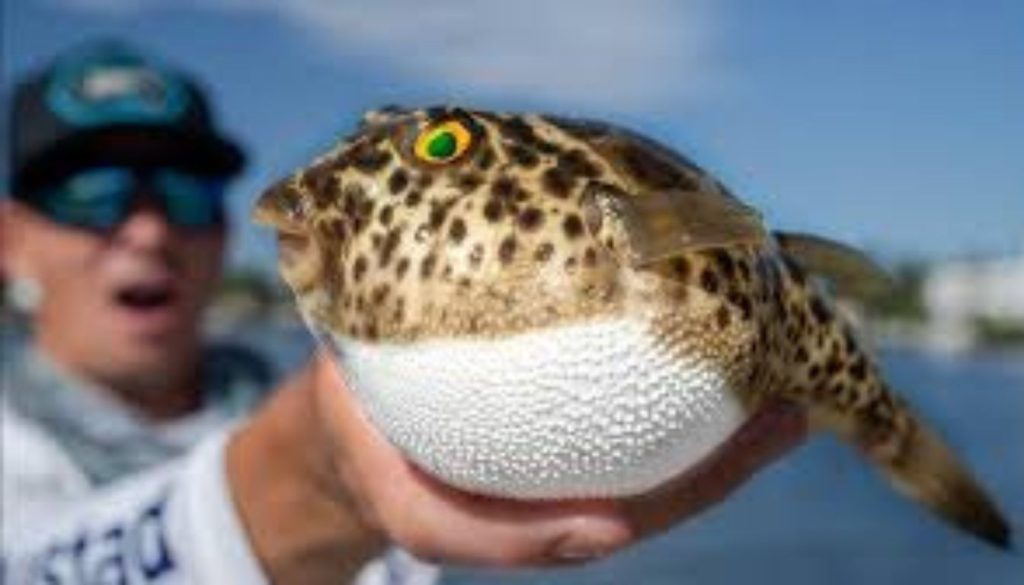
Species Profile
Northern puffers have a distinct appearance and behavior that make them easy to identify and target. Below are the key identification points and reasons to fish for them:
Scientific name / common names: Sphoeroides maculatus (Family Tetraodontidae). Known regionally as northern puffer, blowfish, sugar toad, sea squab or “chicken-of-the-sea”.
Distinctive appearance: Oval, club-shaped body covered in small spines. Dorsally grayish-brown with dark vertical bars and pepper-like spots on the sides/cheeks; belly is yellowish-white. It has a tiny, beak-like mouth and a small dorsal fin set well back. When threatened it can inflate into a ball by swallowing water.
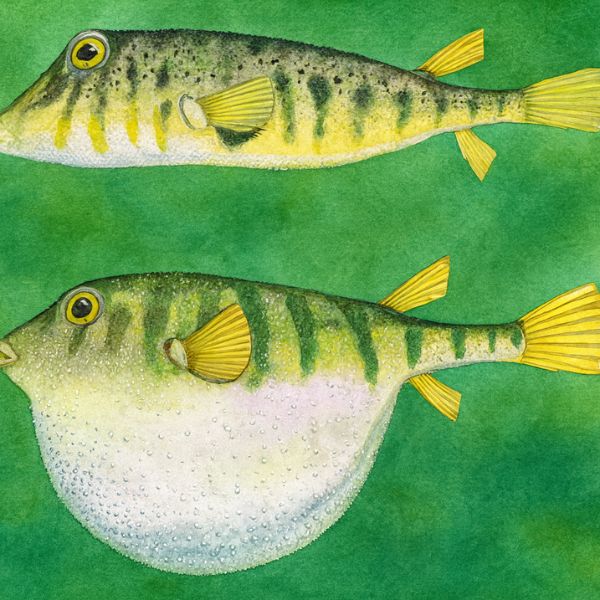
Size: Typically 20–30 cm (8–12 inches) long; maximum around 36 cm (14 inches). Most anglers catch 8–10 inch specimens, though “jumbo” puffer over 1 lb exist (IGFA record ~1.34 lb).
Why Target This Species
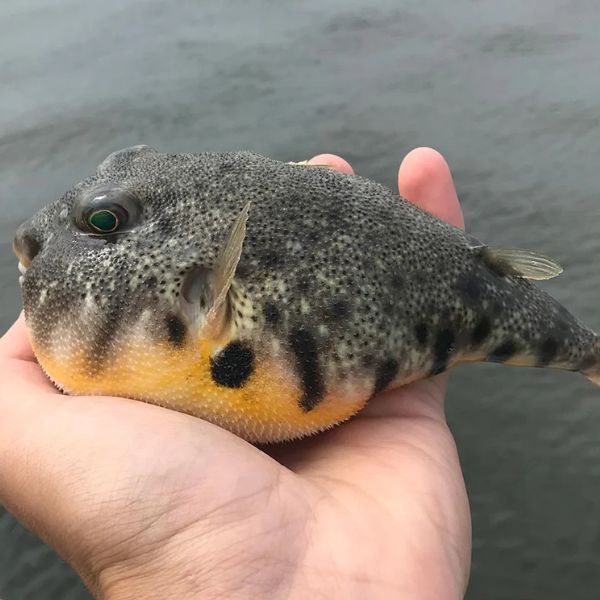
Catch difficulty: Beginner-friendly. Northern puffers readily take small baits and live inshore, making them very easy to catch. They have a light bite, so ultralight tackle improves bite detection. Even novice shore anglers can catch them by the bucketful (often in schools), so the overall challenge is low.
Culinary & sport value: The flesh is edible and non-toxic (only the skin and organs contain tetrodotoxin). Puffers are valued locally as a delicacy with firm, boneless white meat – hence nicknames like “chicken-of-the-sea”. They are not a traditional trophy species, but their fun behavior (inflating on the hook) makes them enjoyable prey. Catching big puffers and kids watching them puff up add to the sport.
Best season: Late spring through summer (May–August) is prime time. This coincides with their spawning and warm-water feeding. (They spawn May–Aug in shallow bays, so feeding activity is highest in summer. Fall and winter see fewer nearshore puffers.)
Behavior and Feeding
Hunting Pattern
Feeding method: Benthic predator. Puffers forage along the bottom, crushing shelled prey with their beak-like jaws. They will actively pursue snails, clams and crabs, sometimes blowing jets of water under a crab to flip it over before attacking. They scavenge in shell beds and weedbeds rather than ambushing open-water prey.
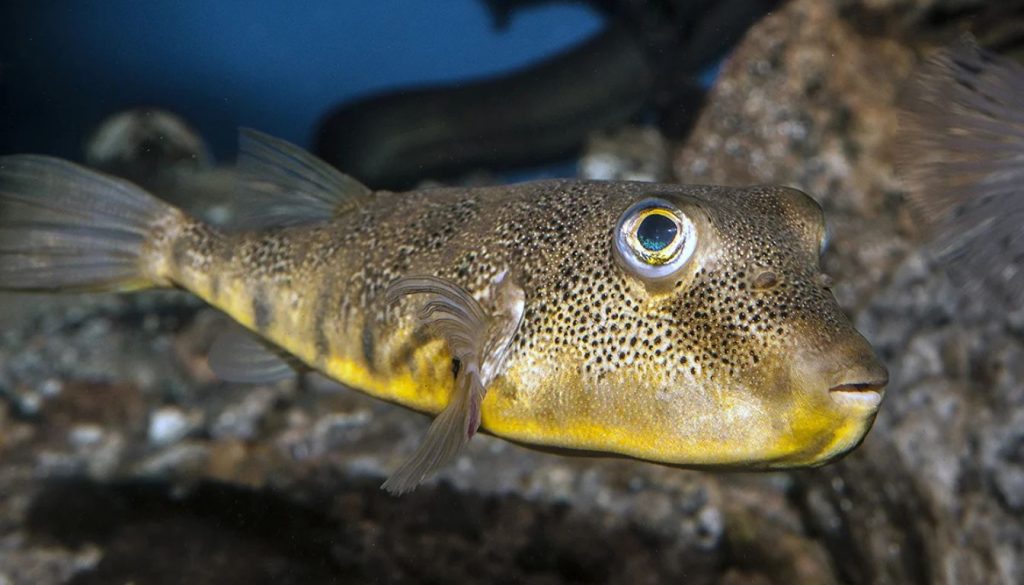
Peak activity: Most active in warm, clear water – typically summer days with water around 68–75°F. They are cold-sensitive, so activity drops in cold water (they avoid <50°F). Puffers will feed throughout daylight hours; experienced anglers report they’ll bite at any time of day or tide.
Schooling vs. solitary: Northern puffers often occur in loose schools or groups. Where one fish is caught, more are usually nearby. Concentrations are especially common in spring and early summer before they disperse.
Primary Diet
Pufferfish Diet Guide
Understanding what pufferfish eat to catch them effectively
🦀 Year-Round Primary Diet
Secondary Prey
Feeding Behavior
🎣 Best Baits: Match Their Natural Prey
Pro Angler Tips
Chumming is key: Create a chum slick with crushed clams, mussels, or fish parts to draw pufferfish into a feeding frenzy. Use small hooks (size 6-8) and fresh bait cut into thumbnail-sized chunks. Pufferfish have small mouths but aggressive bites. A dropper rig keeps your bait near the bottom where puffers feed naturally. Fresh bait always outperforms frozen when targeting these shellfish specialists!
Where and When to Find Them
Key Habitat
- Preferred structure: Bays, estuaries and protected inshore waters. They favor shell beds, rocky bottoms, weedbeds or man-made structure (jetties, piers, docks) where prey like clams and crabs live. Any rough bottom or pilings often hold puffers.
- Depth: Very shallow to moderate. Northern puffers inhabit depths from ~10 m (30 ft) down to 183 m (600 ft). However, in summer they are most common in 3–12 m (10–40 ft) of water. Shore anglers often catch them in 5–15 ft near bays and barrier beaches, while boats may find them on slightly deeper bottoms.
- High-probability zones: U.S. Atlantic waters from Florida through New England. In the Mid-Atlantic and Northeast, major estuaries like Chesapeake Bay, Delaware Bay, Long Island Sound, and the Hudson-Raritan estuary are classic blowfish habitat. Essentially any US east-coast bay or inlet with shellfish can hold them. (Few inlets on the West Coast – focus on Atlantic.)
Fishing Calendar
Optimal Conditions
- Tides: Not tide-dependent. Puffers will feed on both incoming and outgoing tides. Anglers report they bite under most tide conditions, so don’t avoid a tide change – fishing any moving water can work.
- Time windows: Warm, sunny days (water ~68–75°F) usually produce steady activity. Morning through afternoon in summer is good. (They have no strict diel pattern, but midday to late afternoon often sees many bites in shallow bays.)
- Weather: Calm, stable weather is best. Blowfish prefer clear or only mildly turbid water – bright conditions help anglers see them or notice subtle bites. Avoid storm fronts or heavy fog, as puffers feed less in unsettled weather.
Gear and Techniques
Recommended Setup
Primary Gear: Because puffers have light bites and small mouths, a light spinning outfit is ideal. Aim for a 6–6.5 ft light-action rod rated ~8–15 lb, paired with a 2500–3000 size spinning reel. Use 10 lb braided line (or 10–12 lb mono) with an ~8–10 lb fluorocarbon leader. This light setup makes it easier to feel subtle taps.
Rigging: A two-hook bottom rig works best (dropper or flasher rig). Attach two light hooks (size #6 small game/porgy hooks are common) about 6–12 inches apart on the leader. Use one or two split-shot sinkers totaling 1–3 oz (depending on current) about a foot above the bottom hook. This lets your bait hover just off the bottom. Blowfish are notorious bait-stealers, so double hooks increase hook-up chances.
Alternative Setup: In surf or very rough conditions, step up to a 7–8 ft medium spinning rod with 15–20 lb line. Use a similar two-hook rig but with stronger #4 hooks (or a small high-low rig) and heavier sinker (2–4 oz) to handle surf currents. A small bluefish/shark rig (two large hooks) can be used in the surf, but switch to smaller hooks (#4–6) for puffers’ tiny mouths. In boats targeting big puffers or other bottom fish, 12–15 lb line and #4/0 circle hooks work too.
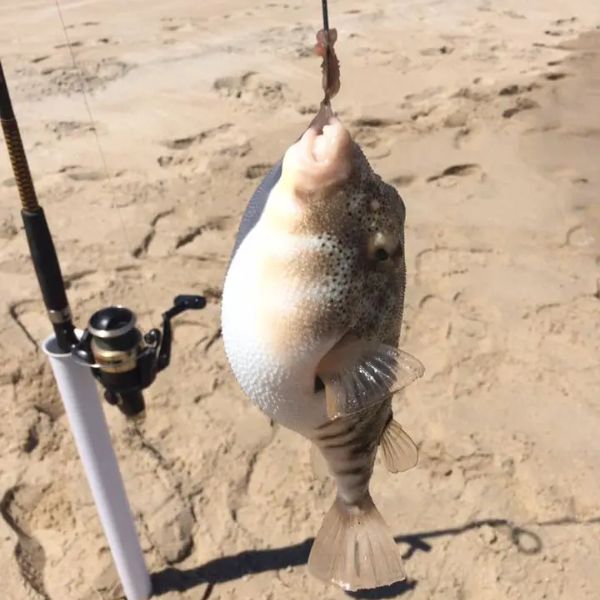
Effective Baits and Lures
Top 3 Natural Baits:
- Clams: Fresh clam meat (littleneck or steamed clam chopped) on hook. Clams are a top bait; many anglers fish half or whole clams on each hook. They can be rigged threaded onto hooks or simply pinned with light circle hooks.
- Squid: Strip or tube pieces of squid (market squid) on hooks. Squid gives a strong scent trail and is readily inhaled. Use strips about 1–2″ long, wrapped on the hook.
- Bloodworms (sandworms): Live or artificial bloodworms/glow-worms on a #6 hook. Sandworms (marsh bloodworms) are irresistible; thread a 2–3″ worm onto a small hook so it trails behind the rig.
(Rigging tip: Use a dropper loop or two-hook rig so you can offer two baits at once. For example, clam halves on one hook and a squid strip on the other. This mimics a cluster of forage.)
Essential Lures: When natural bait isn’t available, small artificial lures can work:
- Soft plastic grub/worm: ~3–4″ curly-tail grub or worm imitation (e.g. Berkley Gulp! Sandworm/Grub) in white, pink or chartreuse. Fish it on a 1/8–1/4 oz jighead near bottom. The slow, pulsing action attracts puffers.
- Soft plastic shrimp: ~2–3″ shrimp or lureking-style bait (pink or flesh color). These mimic small crustaceans. Cast and retrieve very slowly just above the bottom. Puffers are attracted to this realistic profile.
- Jigs or spoons (technique bait): If bites are scarce, try a tiny bucktail jig (1/8–1/4 oz) or mini spoon in bright (silver/chartreuse) colors. Work it slowly on the bottom; puffers aren’t fast, so a slow lift-and-drop can trigger follows.
When to use each: Natural baits (clams, squid, worms) are the go-to choice, fished passively on the bottom rig. Soft plastics work best when drift- or bottom-fishing – cast or drop them and let them sink. A steady, slow retrieve with occasional hops usually outperforms fast jigging (puffers have gentle strikes and aren’t speed feeders). Use plastics in clear water or when chumming has failed to produce fish. Adjust colors to match water clarity – in murky water, brighter chartreuse or pink often outperforms subtle tones.
Fishing Techniques
- Chumming & bottom fishing: Chumming is highly effective. From a boat or pier, anchor and scatter chopped clam bits or commercial chum to bring puffers in. While chumming, present a bottom-rigged bait (clams or squid) on the double dropper. Drift or sit and wait; puffers will often swim into the chum slick and take the closest bait. Keep line taut and be ready – puffers typically pluck slowly, sometimes stealing bait, so strike sharply at the first strong “tug.”
- Still/Drift fishing: If boats are not allowed or you’re on a pier, cast a high/low rig or small bottom rig near likely structure (jetties, rocks, weed edges) and let it settle to the bottom. Drift slowly along a channel edge or reef. Because puffers often cruise slowly, periodically lift and drop the rig a few feet. (They’re not line-shy; keeping slack in the line can help absorb their gentle takes.)
- Alternative (surf/shore): From the surf or shore, use a high/low or sabiki-style rig with small sinkers. Cast parallel to structures (groins, rock piles) and retrieve slowly against the current. On piers, cast alongside piling clusters. Puffers swim into shallow surf to feed in spring, so even a small surf rod with #4–6 hooks can work.
- Pro tips: Use the lightest sinker that still holds bottom to increase bite sensitivity. Always strike quickly – puffers often do a “slow suction” take and then spook off; a quick hook set on initial pull prevents bait theft. When using lures, a very slow retrieve is key (as noted above). Visually spotting these fish can also help – if water is clear, watch for puffers or their boils when they surface to gulp air.
Catch and Handling
During the Fight
Northern puffers are light fighters. They will inflate in panic, but otherwise tend to put up only a modest, wiggly fight. Keep the rod tip up and maintain steady tension; do not lift too abruptly or give sudden slack. Let them run if needed, then reel in smoothly. Because puffers “puff” to escape, if you feel a sudden extra resistance (inflation), ease off slightly and then resume slowly. Avoid jerking or lifting a puffer out of water – support it as soon as you near the surface.
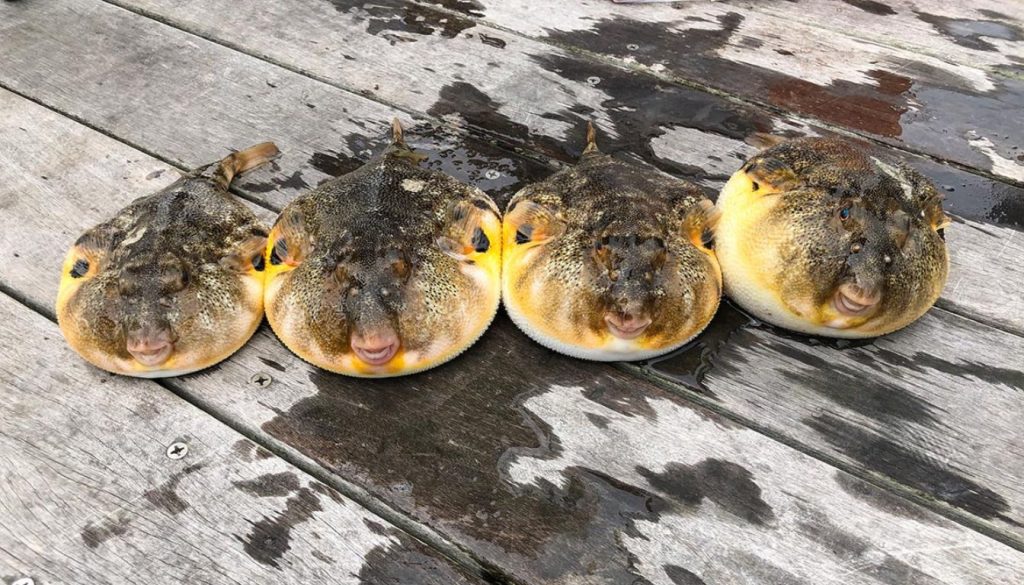
Note: The Fisherman magazine advises using a soft-tip rod, as puffers aren’t fast fish. A common mistake is not setting the hook early; puffers often nip tentatively before sucking in bait, so strike at the first definite pull.
Catch and Release
If releasing, handle carefully. Wear gloves or use a wet towel – puffers have rough spines that can scrape bare hands. Gently cradle the fish (support its belly) – do not grip the inflated body or eyes. When removing the hook, do it quickly to minimize air exposure.
To maximize survival, release the fish upright and underwater as soon as possible. Give it a moment to deflate (some handlers gently squeeze the belly to encourage the puffed water to expel) and swim away. Puffers are hardy; if uninjured and returned quickly, survival rates are high.
For Consumption
If keeping puffers for eating (they are edible when properly cleaned), follow safety and quality steps.
Dispatch: Kill humanely by a quick blow to the head or spike of the brain (to prevent suffering).
Eviscerate immediately: Puffers concentrate toxins in the organs and skin. Carefully remove and discard all viscera, especially liver and ovaries, and peel off the skin. The DNREC advises extreme caution and discarding any fillet that may have contacted organs. (The edible fillets do not contain the deadly tetrodotoxin, but one must be certain there is no cross-contamination.)
For filleting: Make one long cut just behind the head, run the knife along the backbone to detach a fillet, then pull the skin and innards away from the flesh. The meat is white and boneless. Rinse the fillets in saltwater to clean off any residual juice, then keep them cold on ice. Cook or freeze the meat promptly.
Northern puffer flesh is reported to taste mild and flaky – many chefs treat it like chicken or cod. A simple preparation (like the “blowfish fries” recipe popular on Long Island) or pan-frying fillets in butter and lemon highlights the sweet flavor. Under optimal conditions (immediate gutting and icing), puffer fillets keep well and offer a safe, tasty meal.
Sources: Identification and biology from fisheries resources
en.wikipedia.org; fishing techniques from expert angling guides
bait and behavior from bait shops and fisheries (Norrik, Fisherman)
handling from state fishery advisories
